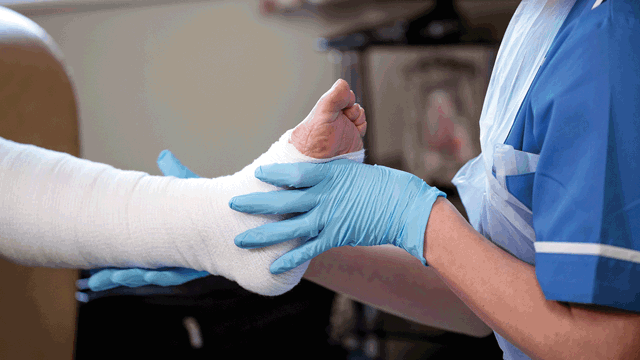Gentle care for burns
Effective burn healing for faster recovery
Most burns are painful and can even be life-changing for the patient. With the right treatment and therapies throughout the healing journey, we can help patients return to their daily life faster.
Tip for healthcare professionals:
Log in to unlock additional clinical articles and resources created specifically for HCPs.
Our approach to healing burns
-
1. Effective burn healing
Undisturbed wound healing should be promoted. Using dressings that minimise the risk of maceration, provide an antimicrobial barrier and allow for long wear time is essential. Pain and stress are contributors to delayed wound healing, therefore it is also key to select a dressing that minimises additional trauma6.
-
2. Patient satisfaction
Experiencing pain and distress is not only a bad foundation for healing, it is also agonising for the patient. Choosing a dressing that minimises pain and anxiety at dressing changes will contribute to higher patient satisfaction.
-
3. Cost-effectiveness
Cost-effectiveness is an important factor in implementing a treatment regimen for burns. Dressings associated with less dressings changes, nursing time or analgesics use can reduce the total cost of care.
Talk to our experts
We’re building a community of knowledge to help prevent and manage wounds. Connect with our clinical experts to share insights, learn from real-world experience, and explore solutions that can improve outcomes for patients.
Start your conversation herePain reduction enabled by Safetac® Technology
Safetac® Technology is the original less-pain contact layer with silicone adhesion. It moulds softly to skin without sticking to the moist wound and it can be easily be removed without damaging the wound or skin1-5,7,8. That means less pain for your patients1-5,9,10-12. Safetac Technology also protects new tissue and intact skin – so wounds remain undisturbed to support faster natural healing. Read more about Safetac Technology here.
-

Without Safetac®
-

With Safetac®
Wound stories
Every burn has its story. Listen to burn survivors and caregivers when they share their experience on burns.
-
References
- Silverstein P. et al. An open, parallel, randomized, comparative, multicenter study to evaluate the cost-effectiveness, performance, tolerance, and safety of a silver-containing soft silicone foam. Journal of Burn Care and Research, 2011.
- Gee Kee E.L. et al. Randomized controlled trial of three burns dressings for partial thickness burns in children. Burns, 2015.
- Gee Kee EL, Stockton K, Kimble RM et al. Cost-effectiveness of silver dressings for paediatric partial thickness burns: An economic evaluation from a randomized controlled trial. Burns 2017, 43(4): 724-732.
- Aggarwala S, Harish V, Roberts S et al. Treatment of partial thickness burns: a prospective, randomised controlled trial comparing Biobrane, Acticoat, Mepilex Ag and Aquacel Ag. J Burn Care Res 2020, 42(5): 934-43.
- Van Overschelde, P. et al. A randomised controlled trial comparing two wound dressings used after elective hip and knee arthroplasty. Poster presentation at 5th Congress of the WUWHS, Florence, Italy, 2016.
- Tang H, Lv G, Fu J et al. An open, parallel, randomized, comparative, multicenter investigation evaluating the efficacy and tolerability of Mepilex Ag versus silver sulfadiazine in the treatment of deep partial-thickness burn injuries. J Trauma Acute Care Surg 2015, 78(5): 1000-1007.
- Upton D, Solowiej K. Pain and stress as contributors to delayed wound healing. Wound Practice and Research 2010, 18(3): 114-122.
- David F. et al. A randomised, controlled, non-inferiority trial comparing the performance of a soft silicone-coated wound contact layer (Mepitel One) with a lipidocolloid wound contact layer (UrgoTul) in the treatment of acute wounds. International Wound Journal, 2017.
- Patton M.L. et al.. An open, prospective, randomized pilot investigation evaluating pain with the use of a soft silicone wound contact layer vs bridal veil and staples on split thickness skin grafts as a primary dressing. Journal of burn care & research, 2013
- Bredow J. et al. Evaluation of Absorbent Versus Conventional Wound Dressing. A Randomized Controlled Study in Orthopedic Surgery. Deutsche Arzteblatt International, 2018.
- Meaume S. et al. A study to compare a new self-adherent soft silicone dressing with a self-adherent polymer dressing in stage II pressure ulcers. Ostomy Wound Management, 2003.
- Gotschall C.S. et al. Prospective, randomized study of the efficacy of Mepitel on children with partial-thickness scalds. Journal of Burn Care & Rehabilitation, 1998.
Related articles
Read all-

Wound care | 1 min read What is a venous leg ulcer?
-

Wound care | 2 min read What can I do to heal my venous leg ulcer?
-

Wound care | 1 min read Why is compression important?
-

Wound care | 2 min read Support your healing by making the right choices
-

Wound care | 1 min read How to lower risk of infection
-

Wound care | 1 min read How can I tell if I have an infection?
-

Wound care | 2 min read Prevention and first-aid measures for burns
Burns happen to people every day all over the world. But most burns are preventable, and by knowing the best way to treat a burn with first aid it's often possible to reduce their severity.
-

Wound care | 5 min read Choose the right treatment first time, every time
It’s international Stop Wound Infection Day on Thursday 16 October – and here’s how you can play your part. By using the right treatment to treat infection, first time, every time, healthcare professionals can not only treat wound infections effectively but also maintain sound antimicrobial stewardship. Here’s how to get the balance right.
-

Wound care | 7 min read Top 7 tips for wound healing
You probably don’t think much about wound care until you have surgery or an accident, or you have an ongoing hard-to-heal wound such as those caused by diabetes. But this year’s Wound Awareness Week (September 1–7) is urging us to Be Wound Aware because “Wounds affect EVERY body” and even a minor injury can become a serious long-term problem if you don’t care for your wound. Follow these seven tips to give yourself the best chance of recovery without complications.
Access restricted to healthcare professionals
To access this content, please confirm you are a healthcare professional.
Login to continue Don’t have an account? Sign up




